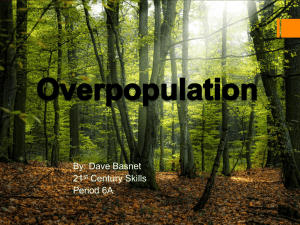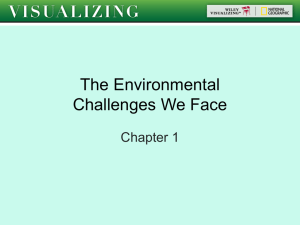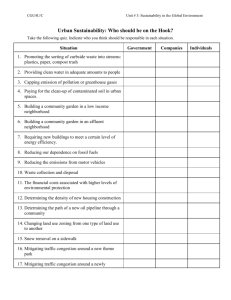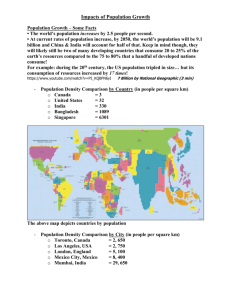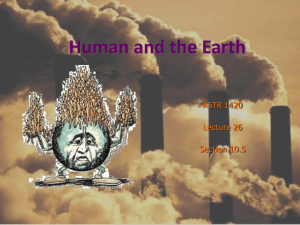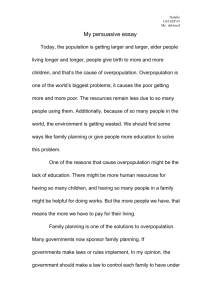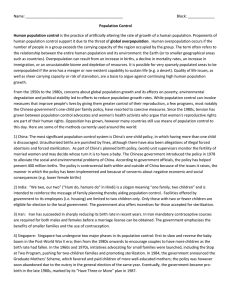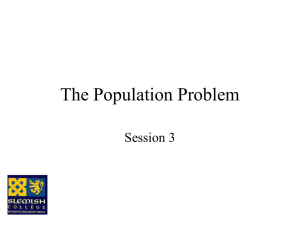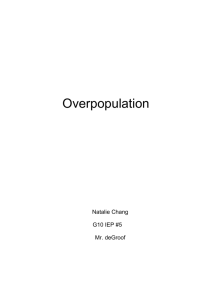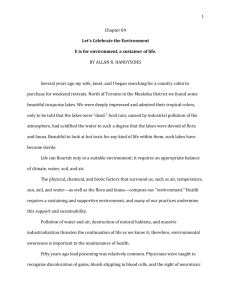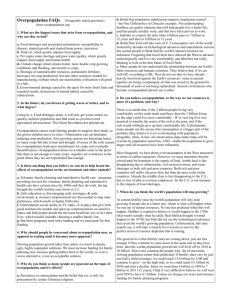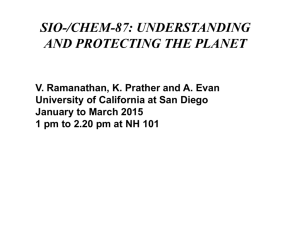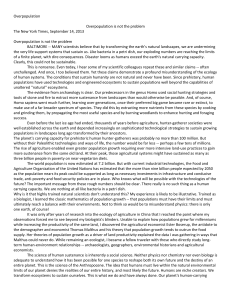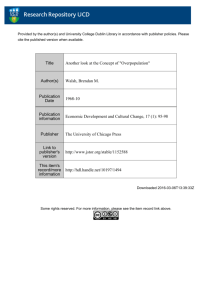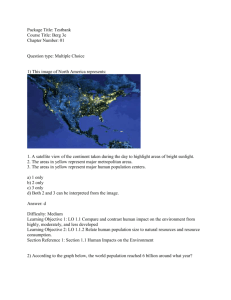Introducing Environmental Science and Sustainability
advertisement
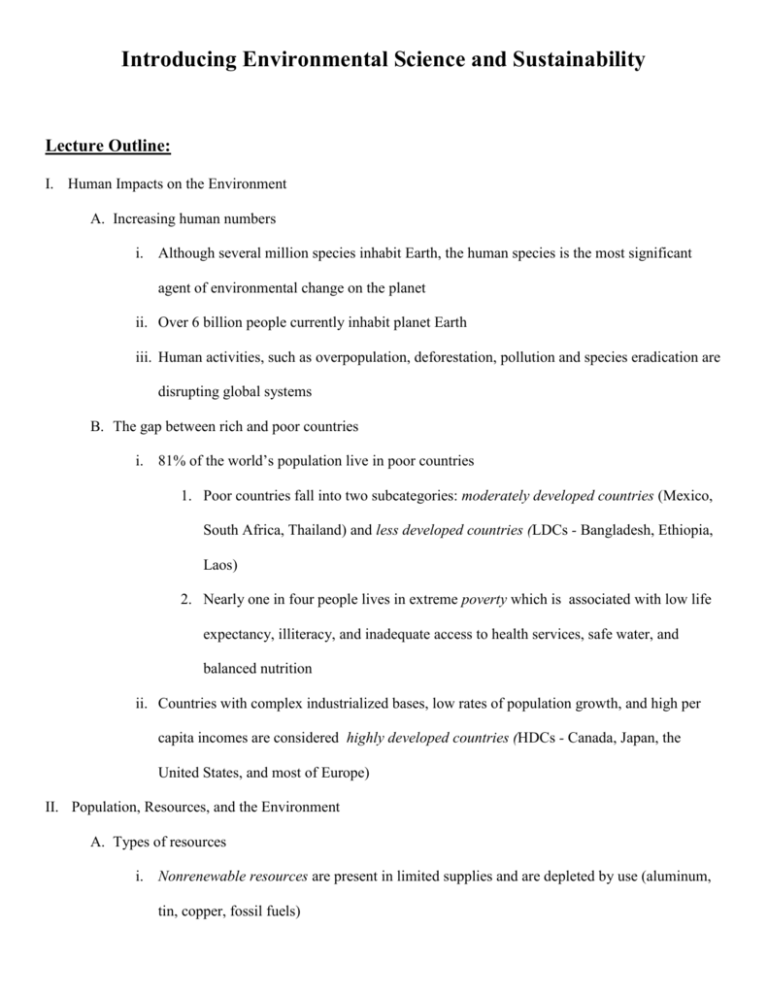
Introducing Environmental Science and Sustainability Lecture Outline: I. Human Impacts on the Environment A. Increasing human numbers i. Although several million species inhabit Earth, the human species is the most significant agent of environmental change on the planet ii. Over 6 billion people currently inhabit planet Earth iii. Human activities, such as overpopulation, deforestation, pollution and species eradication are disrupting global systems B. The gap between rich and poor countries i. 81% of the world’s population live in poor countries 1. Poor countries fall into two subcategories: moderately developed countries (Mexico, South Africa, Thailand) and less developed countries (LDCs - Bangladesh, Ethiopia, Laos) 2. Nearly one in four people lives in extreme poverty which is associated with low life expectancy, illiteracy, and inadequate access to health services, safe water, and balanced nutrition ii. Countries with complex industrialized bases, low rates of population growth, and high per capita incomes are considered highly developed countries (HDCs - Canada, Japan, the United States, and most of Europe) II. Population, Resources, and the Environment A. Types of resources i. Nonrenewable resources are present in limited supplies and are depleted by use (aluminum, tin, copper, fossil fuels) ii. Renewable resources are replaced by nature fairly rapidly and can be used forever as long as they are not overexploited in the short term (trees, animals, soils, fresh water) B. Resource consumption i. Consumption is the human use of materials ii. A single child born in a HDC causes a greater impact on the environment and on resource depletion than 12 or more children born in a developing country C. People overpopulation and consumption overpopulation i. A country is overpopulated if the level of demand on its resource base results in damage to the environment ii. A country can be overpopulated in two ways: people overpopulation (LDCs) and consumption overpopulation (HDCs) iii. The amount of productive land, fresh water, and ocean required on a continuous basis to supply a person food, wood, energy, water, housing, clothing, transportation, and waste disposal is termed an ecological footprint D. The IPAT model i. The IPAT model shows the mathematical relationship between environmental impacts and the forces driving them: I = P x A x T ii. The three most important factors in determining environmental impact (I) are: number of people (P), the affluence per person (A), and the environmental effects of the technologies used to obtain and consume resources (T) III. Environmental Sustainability A. When the environment is used sustainably, humanity’s present needs are met without endangering the welfare of future generations B. Inadequate understanding of how the environment works and how human choices affect the environment is a major reason that problems of environmental sustainability are difficult to resolve C. Sustainability and the Tragedy of the Commons i. Proposed by Garrett Hardin in 1968, he postulates that our inability to solve many environmental problems is the result of a struggle between short-term individual welfare and long-term environmental sustainability and societal welfare ii. Effective legal and economic policies are needed to prevent the short-term degradation of our global commons iii. The shared responsibility for the sustainable care of our planet is termed stewardship D. Global plans for sustainable development i. The goals of Agenda 21 are achieving improved living conditions for all people while maintaining a healthy environment in which natural resources are not overused and excessive pollution is not generated iii. Three factors interact to promote sustainable development: environmentally sound decisions, economically viable decisions, and socially equitable decisions IV. Environmental Science A. Environmental science encompasses the many interconnected issues involving human population, Earth’s natural resources, and environmental pollution B. Earth systems and environmental science i. Understanding how systems that consist of many interacting parts function as a whole help scientists gain valuable insights that are not obvious when looking at system components ii. Environmental scientists often use models to describe the interaction within and among environmental systems iii. Many aspects of Earth’s systems are in a steady state of dynamic equilibrium 1. Feedback occurs when a change in one part of the system leads to a change in another part 2. A negative feedback mechanism works to keep an undisturbed system in dynamic equilibrium, and occurs when a change in some condition triggers a response that counteracts, or reverses, the changed condition 3. A positive feedback mechanism leads to greater change from the original condition, and occurs when a change in some condition triggers a response that intensifies the changing condition C. Science as a process i. There is no absolute certainty or universal agreement about anything in science; it is selfcorrecting over time ii. The established processes scientists use to answer questions or solve problems are collectively called the scientific method 1. The scientific method involves five steps: recognize a problem or unanswered question, develop a hypothesis, design and perform an experiment to test the hypothesis, analyze and interpret the data to reach a conclusion, share new knowledge 2. Scientists collect objective data by observation and experimentation a. Inductive reasoning is the basis of modern experimental science b. Deductive reasoning is used to determine the type of experiment or observations necessary to test a hypothesis 3. Controls and variables are accounted for in experimental design 4. Scientific theories are integrated explanations of numerous hypotheses, each supported by a large body of observations and experiments and evaluated by the peer review process V. Addressing Environmental Problems A. There are five stages in addressing an environmental problem: scientific assessment, risk analysis, public education and involvement, political action, evaluation B. The reversal of the pollution of Lake Washington is a clear example of how environmental science identifies and addresses environmental problems (CASE IN POINT: Lake Washington)
![[标签:标题]](http://s3.studylib.net/store/data/007514640_1-d06ca384d6a6efac05ae8c0c925f8675-300x300.png)
